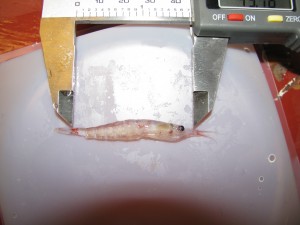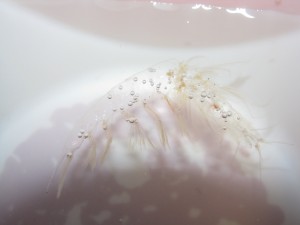Since we ended up with a nice mix of sub-adults (essentially krill in their late “teens”) and juveniles on our first krill delivery, we decided it would be a good time to conduct a juvenile growth experiment. Much like most animals, krill grow more quickly in their early stages than they do once they are nearly full grown – so the juveniles we got are ideal for this kind of an experiment.
We set up three treatments, as usual, each with 30 krill in their own jars. Each jar was observed daily, to see if the krill had molted. Krill do not grow continuously, but they can increase size (or sometimes decrease) each time they molt. Each time a krill molted, we weighed it and measured its length, as well as the length of the exoskeleton it shed. This allowed us to calculate what’s called the growth interval, between the krill and molt lengths.
Krill typically molt every 30 days or so, and about 25 days later we only have one straggler that hasn’t molted yet. The krill in the high temperature treatment seemed to molt much more quickly than those in the control and high CO2 treatments. This isn’t entirely too surprising, since most biological rates in ectothermic (“cold blooded”) organisms increase as temperature does. It also seems that these guys had a smaller (or negative) growth interval, as compared to the ones in the other treatments. One potential explanation for this is that, under higher temperature conditions, the krill have to devote more energy to metabolism than to growth, but it’s too early to call for sure.



Comments are closed.